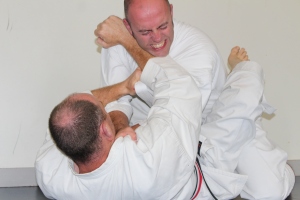Like all of the “blocks” in karate, kake uke is really a repositioning and transition movement that is used to move the attacker off balance and to present a number of ways to counter the initial attack. Many styles of karate practiced in Ireland don’t practice this as a part of their kihon waza. It appears in kata, but many traditional styles don’t recognise seizing (and the related grappling) as part of the karate arsenal. However, it is most definitely a part of the techniques of “human-ryu” and as such must be explored to help develop the “toolbox” that a karate ka carries with them. A seize changes the distance of the engagement and, by definition, changes the tools needed to protect and control.
In traditional karate, kake uke would be used against a stepping punch. The defender moves to the outside of the punch and executes the hooking block or kake uke. Once blocked, the defender grabs the attacker’s arm and then, in the one step sparring scenario, pulls the attacker in as they use a mae geri or front kick to counter. For many of us, this is where we started.
However, kake uke really deserves a proper exploration and substantial practice to develop the effective application of this technique. Uke is translated as “receive”. Rather than being a hard block as is commonly taught, receiving allows for the redirection of energy and the use of this energy against the aggressor. Kake means hook. So the phrase kake uke can be translated as a hooking block, but is better thought of as receiving an attack using a hooking motion (quite a mouthful).
This receiving motion is only the starting position for countering the attack or controlling the aggressor. Practicing uke techniques on a straight line against a stepping punch is only the first step. Like all of the uke techniques in karate, they are not meant to be a static block followed by a reverse punch. Karate-ka need to realise that they need a dictionary of techniques that can be picked and chosen depending on the context of the engagement. This dictionary has to include joint locks, take-downs, chokes & strangulations (yes, they are different), seizing and pressure point manipulation. There are many techniques in each category to choose from in any situation, but unless they are practiced and drilled with a partner using varying levels of resistance, then they will be of little use to a karate ka when they are needed.
Context
Rather than looking at a stepping punch as the initial attack (highly unlikely outside the dojo), let us look at some common acts of aggression that can often be preludes to a much more serious and realistic engagement.
The first is from a wrist grab that is used by an aggressor to turn someone and gain some control over them. Most likely, due to a right handed dominance in society, the grab will be with the left hand so that the aggressor can use their right hand to assert control or to simply punch with the stronger hand. In the event of being turned, instinct will kick in for the defender. As they are turned, the free hand will automatically rise to protect the face and check the attackers other hand.

Another context is that of a front bear hug. In this instance, let us consider the over arm bear hug. Imagine that the defender raises their left hand into an uchi uke position and reaches into grab the attackers groin with the right hand. In this case, the defender has forced the attacker to grab their right wrist with their left hand. The attacker’s right hand, while stronger, has been stopped by the defenders left hand. The defender has taken control to bring the situation back to a same side wrist grab with their right hand being seized.
Of course, the kake uke can also be used to counter a single or double handed shove. This is the familiar scenario that has been formalised into the stepping punch in a one-step sparring environment. However, as we all know, this scenario has very limited use in training for real effectiveness. It needs to be moved beyond the static attack of the oi-tsuki. In the event of a shove with the attacker’s left hand, the defender checks with their right, hooks with the left and then grabs the attacker with the left hand.
Positioning
Breaking the grip of someone larger needs more than just strength and speed. There are small details in the execution of kake uke that make it much more effective.
Keep the elbows tight! If the elbows are away from the body, then it becomes a battle to see who has the strongest arms. If an attacker reaches and successfully grabs, then by default, their arm is away from their body. When the defender keeps their elbow close to their body, then they will be using their body weight against the attacker’s arm, so the grip can be successfully broken. If the successful outcome for the defender is to break the grip and run, then this can be achieved by using body weight against arm strength.
Straighten the attacker’s arm! If the attacker can bend their arm, then it gets closer to their body and they will begin to assert their dominance through strength. To avoid this, a shuffle backwards away from the attacker will allow the defender to pull the grabbing arm straight. This has a number of benefits (for the defender!). The first is the distance gained by moving back. The second is that the straight arm can be used like a pole to pull and push the attacker to put them off balance. The third is that the hand at the end of the straight arm is more vulnerable and a small joint lock can be easily applied to force the attacker up on their toes and utilise the second advantage given.
Learn some physics! Karate ka are often surprised at how much physics plays a part in their martial arts. Whether they realise it or not, the principles of physics transfer directly across to unarmed person-to-person engagement. Once the defender has reversed the grip and is now holding the attackers wrist, they can use their free hand to push on the outside of the straightened elbow. For those familiar with it, this is a class three lever where the effort is applied between the load (the attacker’s body) and the fulcrum (defenders hand in hikite position). This will, in effect, push the attacker to the ground and allow the defender to exert control over them.
Movement
It is important to gain control while moving away from the attacker’s free hand to reduce the risk of it making contact. This requires ashi sabaki or foot movement. At the very least, this will be a side step or a small shuffle backwards in order to receive the oncoming attack after the point of maximum velocity. Following this with a shuffle forward and a body twist will ensure that the attacker does not get a chance to regain balance before the defender can control them. The attacker will be thrown backwards and forwards in quick succession, thus breaking their balance and not giving them a chance to re-assert control.
Ashi sabaki and tai sabaki are both required to make the kake uke an effective technique. It is imperative that the attacker is not given the chance to regain balance in order that their arm can be used as a lever against them. The synergy provided by the elements as they work efficiently together is greater that one could imagine on first examination. This, once again, reinforces the need for a compliant training partner to understand the physics and motion required to initially learn the technique. After the dynamics of kake uke are understood and practiced, the veracity of that understanding can be tested by increasing the resistance and force used by the training partner in safely recreating the scenario in the dojo.
Kake uke is an open handed technique that is related to the more “advanced” Chinese open handed techniques. If you close the fist, as the Okinawans did in Sanchin kata, then the application of kake uke completely disappears. This is one of the key differences between common “traditional” styles of karate and Koryu Uchinadi. Koryu Uchinadi introduces realistic acts of violence immediately in training as a part of the kihon waza curriculum, building up a repertoire of defences that are later easily recognised by the student when they start to study kata.
Damien Costello is a renshi level instructor in Koryu Uchinadi Kenpo Jutsu. Based in Galway, he is a student of Hanshi Patrick McCarthy. Further information about Koryu Uchinadi in Ireland can be found at www.ku-ireland.com
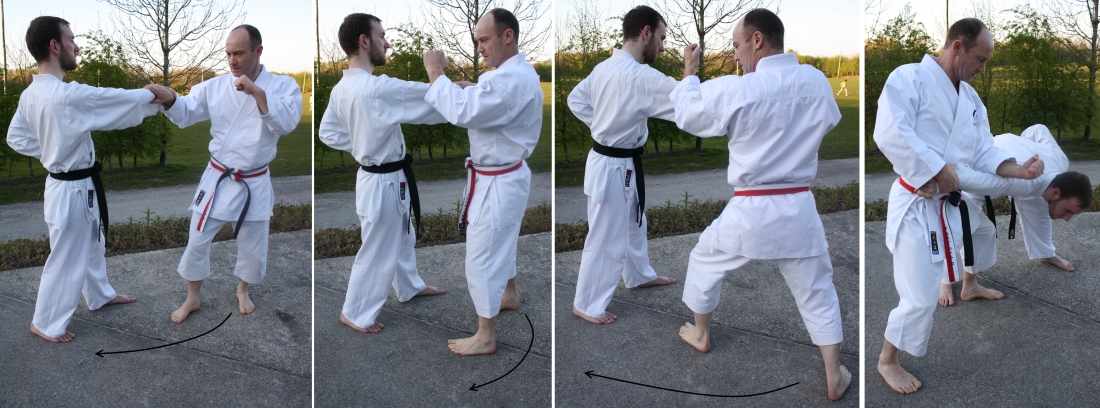

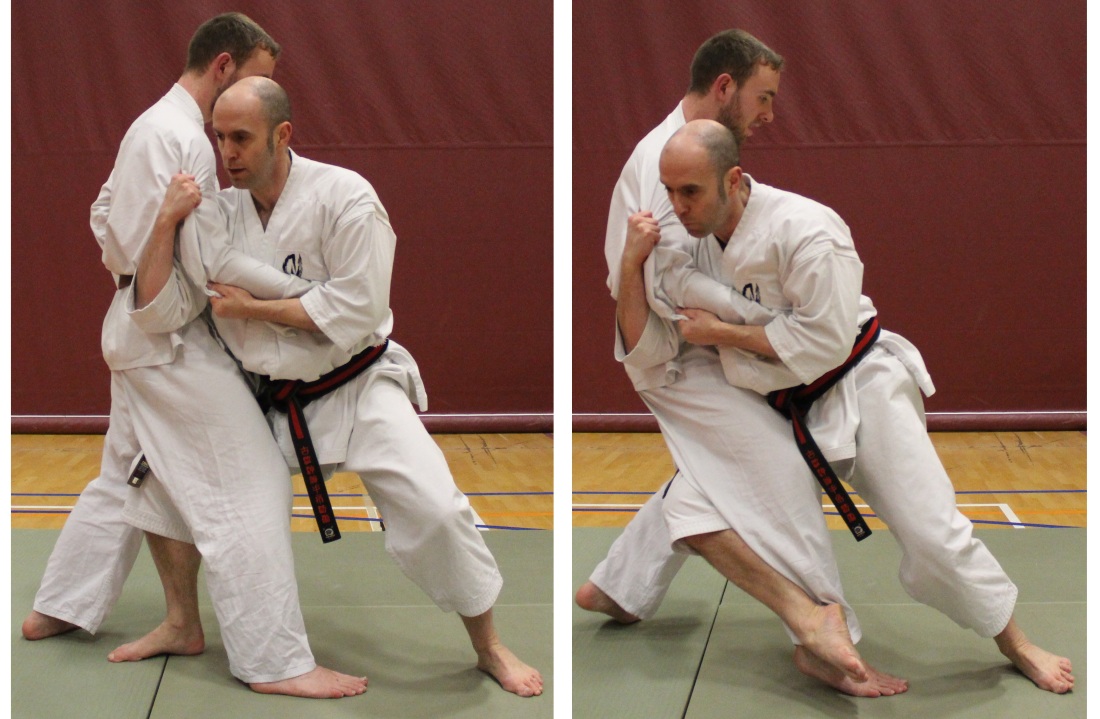
 The wrist grab is a common contextual premise that very often is a precursor to a hook punch or a reach for the face or neck. As shown, the defender uses the hikite hand (in this case, the left) to change the grip and hold on to the attacker. At the same time, the right hand sweeps up to slap the attacker across the face (distraction/hidden technique) and then bring the hand down to use the gedan barai as a lever to force the attacker towards the ground. Although the defender never wants to end up on the ground, there is no reason not to put the attacker on the ground in order to provide a window of escape. As the attacker is pushed down, they will use their free arm to stop themselves, thus removing the immediate danger of being hit by it. The possibilities for follow up in this scenario include simply leaving the scene, forcing the attacker face first into the ground or reaching through the grab the leg and roll the attacker.
The wrist grab is a common contextual premise that very often is a precursor to a hook punch or a reach for the face or neck. As shown, the defender uses the hikite hand (in this case, the left) to change the grip and hold on to the attacker. At the same time, the right hand sweeps up to slap the attacker across the face (distraction/hidden technique) and then bring the hand down to use the gedan barai as a lever to force the attacker towards the ground. Although the defender never wants to end up on the ground, there is no reason not to put the attacker on the ground in order to provide a window of escape. As the attacker is pushed down, they will use their free arm to stop themselves, thus removing the immediate danger of being hit by it. The possibilities for follow up in this scenario include simply leaving the scene, forcing the attacker face first into the ground or reaching through the grab the leg and roll the attacker. A side bear hug, in this case under the arms, is used to control a person or even lift them off their feet. In a scenario like this, a distraction technique is essential. From this position, a head butt or an elbow to the attacker’s face will cause a slight loosening of the grip. This will allow the defender to grab the attacker’s wrist with the left hand and as the right had returns, a strong base is formed. The step back into gedan barai will drive the defender’s leg under the attacker’s, displacing their balance and most certainly end up with the being thrown to the ground.
A side bear hug, in this case under the arms, is used to control a person or even lift them off their feet. In a scenario like this, a distraction technique is essential. From this position, a head butt or an elbow to the attacker’s face will cause a slight loosening of the grip. This will allow the defender to grab the attacker’s wrist with the left hand and as the right had returns, a strong base is formed. The step back into gedan barai will drive the defender’s leg under the attacker’s, displacing their balance and most certainly end up with the being thrown to the ground.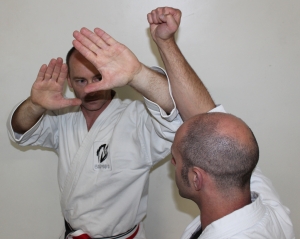 However, this just means to raise your hands and the stopping point is elevated in front of the head. In a practical context, this represents the forming of a defensive perimeter at any level depending on the angle of attack as shown in the picture.
However, this just means to raise your hands and the stopping point is elevated in front of the head. In a practical context, this represents the forming of a defensive perimeter at any level depending on the angle of attack as shown in the picture.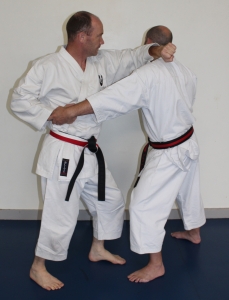 The net result is a temporary and non-lethal disruption of blood supply to the brain which in turn causes a brief weakness in the opponent allowing for an appropriate follow up to disengage.
The net result is a temporary and non-lethal disruption of blood supply to the brain which in turn causes a brief weakness in the opponent allowing for an appropriate follow up to disengage.